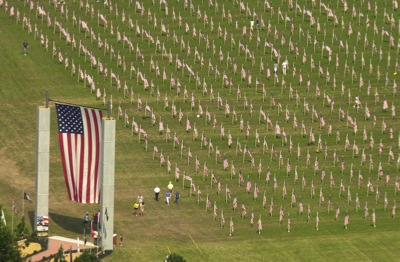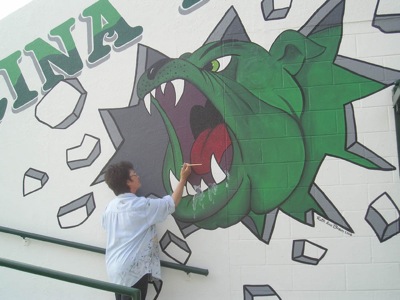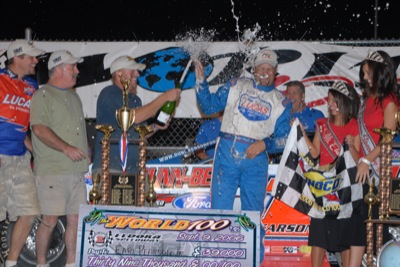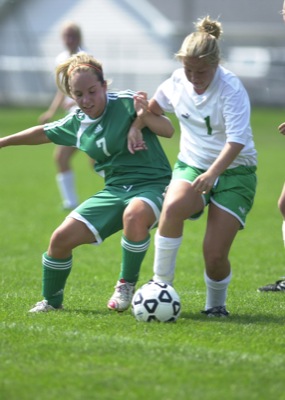Monday, September 11th, 2006
A time to remember
By Margie Wuebker

Photo by Mark Pummell/The Daily Standard
Twin towers bearing a huge American flag form the entrance to the West Ohio Healing Field at the Spiritual Center of Maria Stein. Some 3,500 smaller flags honor fallen soldiers, men and women currently serving in the military, veterans, firefighters, police officers and emergency medical services personnel. The observance, which began Saturday morning, continues through 5 p.m. Tuesday.
MARIA STEIN - American flags wave in the breeze - 3,500 of them honoring the military veterans, men and women serving in the military far from home and scores of firefighters, law enforcement officers and emergency medical services personnel.
That does not count nearly 500 star-spangled banners lining St. Johns Road. They will remain in place through Tuesday as part of the West Ohio Healing Field taking place on the grounds of the Maria Stein Center.
Tears welled in the eyes of honorary New York firefighter and medic Michael Bellone as he viewed the patriotic display as well as two silver towers at the entrance. People around him remarked about the mammoth flag hanging between those towers.
A different scene played out before his eyes - the inspiring twin towers of the World Trade Center in New York City. Beginning at 8:46 a.m. Sept. 11, 2001, television cameras and world attention focused on the landmarks in the wake of an unfathomable terroist attack.
Firefighters, police officers and rescue personnel raced into the buildings intent on saving lives. Instead they were lost along with trapped workers when the towers fell amid choking smoke, flying debris and then unnatural silence.
Bellone, who came to Maria Stein with fellow members of New York's Trauma Response Assist for Children, spent 257 straight days involved in recovery efforts at ground zero.
"I had worked the night shift handling security at a night club and was in bed sleeping when the call came," the retired supermarket manager recalls. "Help was needed especially from anyone with medical experience."
He hitched a ride aboard a passing fire truck and arrived at what he describes as a "110-degree hell." He initially planned to set up a triage unit, but firefighters pressed him into joining the recovery effort.
Someone passed him a white cotton painter's mask as a defense against the toxic fumes and dust.
"That little mask prevented my nosebleed from getting all over my shirt," he says. "We needed respirators but there was none to be had."
He and others involved in the recovery mission had no time to think and no time to cry. Lifting a chunk of concrete or removing a metal beam in hopes of finding someone alive became a mission above no other.
His group was among the first to go down to the subway beneath the massive structures to look for victims. Before heading down, he and the others were told to roll up their sleeves and pants legs. Someone quickly wrote their social security numbers on exposed arms and legs with indelible markers.
"That does not give you the greatest feeling in the world," he says. "Those numbers were a source of identity if you didn't make it out."
Bellone and the men working with him found a lot of bodies, including many without arms, legs or heads. They accorded each special honors - tucking an American flag over the black bag on the stretcher and then forming an honor guard for the grim procession up to the street.
An honorary firefighter with Ladder Company 20, he was moved when searchers discovered a fire truck 60 feet below street level.
"We were afraid to let the heavy equipment move in because we did not know whether firefighters were still inside the cab or whether they had sought safety beneath the vehicle," Bellone says. "Seven wives stood together on the street as we dug by hand for 25 hours."
Seven compartment doors out of 16 were found intact. The doors were taken off and given to the seven women waiting for word.
"Out of something so bad, we found something beautiful," he says. "The discovery of the truck and the dedication of those wives on the street only spurred us on."
On March 12 while digging in the area of the south tower, the searchers found one firefighter and shortly thereafter six others. Prayers had been answered.
"A total of 343 firefighters died Sept. 11; we only found 189 (bodies)," he says grimly before sharing another touching story.
The last run for firefighter Jimmy Riches Jr. took place Sept. 11. Riches had been scheduled to be off that day but traded with someone else so he would be off for his Sept. 12 birthday.
"His father (a fire chief) was there every day except for one (March 25)," Bellone says. "We found Jimmy after 30 minutes of digging that morning."
The chief and his four sons came to the site and carried the flag-draped stretcher up to the street.
"I stood there in the honor guard realizing this was the last time that family would be together," he says in a voice ripe with emotion. "A lot of things happened in the wake of Sept. 11 that were not coincidences."
He also recalls the day when digging efforts revealed a blue skirt, then one side of a body and finally a pair of wings still attached to the lapel of a woman's jacket. Given the location and the information retrieved at the scene, the parents of a stewardess aboard ill-fated flight 11 were able to bring their daughter home to her final resting place.
Bellone still struggles with the loss of 15 "brothers" from Ladder Company 20 as well as nearly 35 men who worked with him in the debris.
A combination of asbestos, jet fuel, freon, bleach, ammonia, sulfuric phosphate, cadmium and a host of other chemicals has left him with 18 percent lung function. His blood contains platelets from unknown victims incincerated to nothing but dust by temperatures reaching thousands of degrees inside the towers.
"Five years later I still think about what we lost that day," he says. "Hug your family every day and don't miss a day. Thank a firefighter, or a police officer or an EMT. We are really lent to each other for a little while and no one knows what tomorrow holds."
Bellone believes Americans are safer today than they were five years ago on Sept. 11.
"We pay a strong price for our freedom and yet people wonder why we keep sending men and women to Afghanistan and Iraq, " he says. "People in those faraway lands spend 100 percent of their time thinking how to get us. We are a country rich with heroes - military personnel who protect our freedom and the brave individuals who thought of others before themselves Sept. 11. Let us never forget the sacrifices of many."



